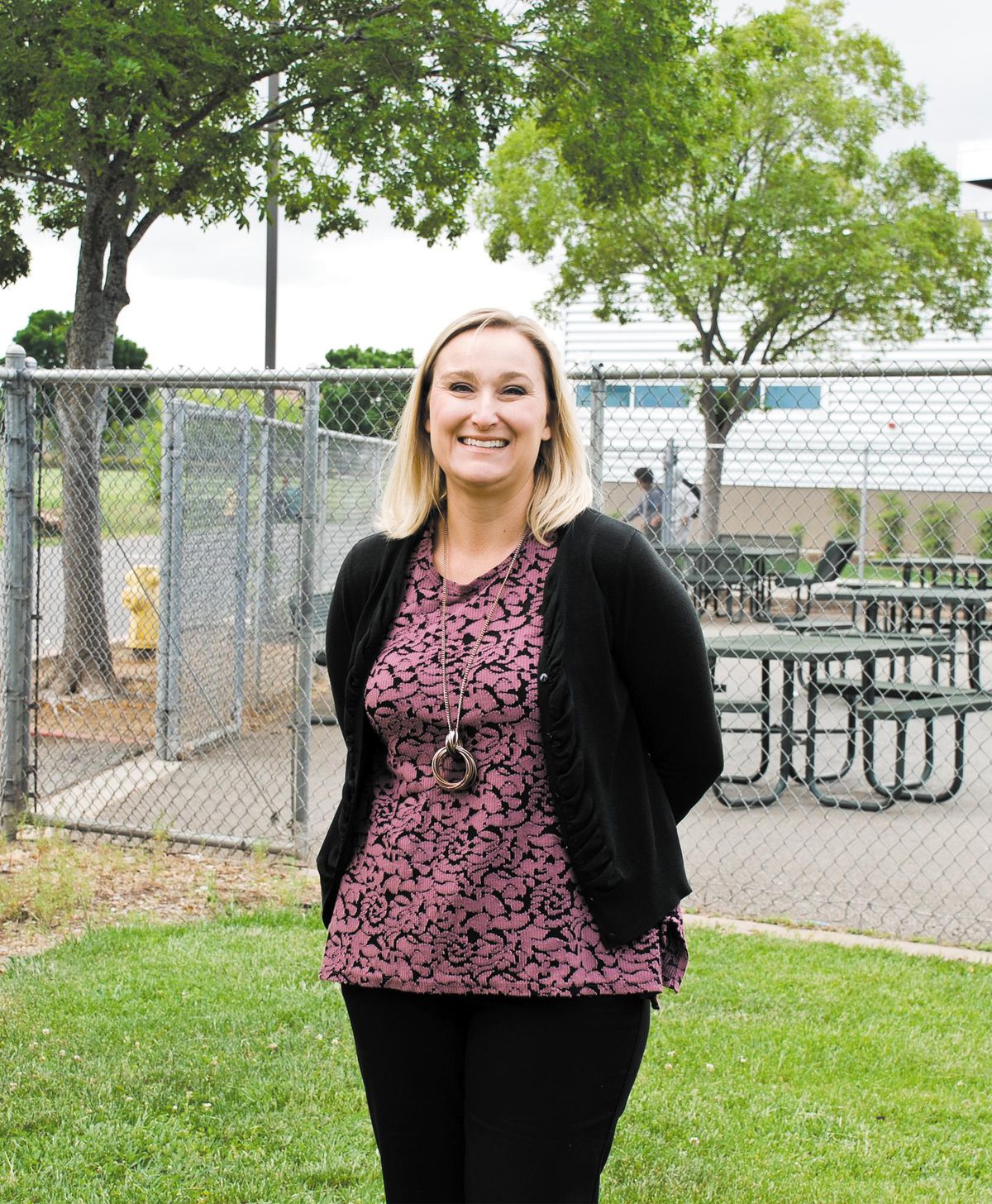
Photo by Evan Tuchinsky
Jessica Kamph, principal of Marsh Junior High, stands on the campus plot that soon will become a garden where students can relieve stress through horticulture.
Middle school years, even in the best of circumstances, represent a time of transition. Students enter adolescence while facing increased pressures, socially and academically. Internet images, videos and comments add heat to the crucible.
Jessica Kamph and Sheila Snyder—principal and counselor, respectively, at Marsh Junior High in Chico—see the signs every day. Emotional issues permeate campus. Beyond their angst and tension, kids all too frequently resort to self-injuring practices such as cutting as psychological mechanisms to cope.
“The safest place in the world, hopefully, will be in their own home with their family in their room,” Snyder said. “That [electronic] device is still a portal, they’re still vulnerable, and so I think that’s been a huge contributor to some of the anxiety, the stress, the depression, the self-harm that we’re seeing.”
What about those who’ve lost their home?
Marsh is one of numerous schools across Butte County with Camp Fire refugees. Forty-two Marsh students lost their homes in the Nov. 8 firestorm that swept from Pulga over the Ridge into Butte Creek Canyon. Another 20 newly enrolled after their families relocated to Chico. All told, the Chico Unified School District accepted 321 students displaced from the burn area (see “Coming together for the kids,” cover story, page 19).
In the aftermath, Kamph said, many have found themselves “in really tight living quarters,” sharing a bedroom, “and they’re not used to not having the things around them that they had every day. They don’t feel like anything’s theirs—that identity, ‘my home’—and kind of feel like they’re floating out there.”
Soon, they’ll have a place at school to find grounding.
Marsh received a grant from the Camp Fire Relief Fund, administered by the North Valley Community Foundation, to create a calming room. Also known as reset rooms, these spaces provide a quieting environment where students can seek a brief respite to ease agitation. Pleasant Valley High has a place set aside inside its learning center; Chico Junior High has its “Zen Den,” a room dedicated fully to calming; and Bidwell Junior recently set up a room.
Chapman Elementary, whose counselor devotes part of her office to a calming space, last year had “the Blue Room.” That served as a model for the Palermo School District, another beneficiary of Camp Fire Relief funding. Serving kindergarteners through eighth-graders south of Oroville, the Palermo district received grants for calming rooms and additional counseling staff.
“When we look at what interventions are best for these children who’ve experienced trauma, we find that giving them strategies and space to self-regulate really is the best thing,” Rainbow Walker, Palermo’s district counselor, said by phone.
“They know they can’t spend the whole day in there—it’s not going to be a chance for them to get out of class and miss work. They have 10 minutes to go in if they’re having a rough morning, or something happened throughout the day, so they can go back and learn.”
Marsh actually will have two calming spaces—a room and a garden—for which NVCF awarded the school $5,000.
The calming room will subsume the current staff room. Cabinetry and the copier will remain, but other furniture will make way for various types of seating and equipment befitting the new use.
Ann Murphy, counselor at Chico Junior, describes the Zen Den in much the same way Snyder envisions the Gator Getaway (named after Marsh’s mascot). Murphy’s space has places with privacy and spots for stress-relieving activities such as Legos, raking sand and a punching bag. She or a colleague supervises. After around 15 minutes, the student either says he (or she) is ready to return to class or talks out the issue with the counselor.
“Whatever the need is for the child to reset, recharge, we’ve got them all,” Murphy said by phone. “We teach them coping skills to put in their tool belt.”
She said 98 percent of students who come to the Zen Den finish out the school day without incident—resulting in a decrease of disciplinary actions, including suspensions, and an increase in attendance. Walker said her district’s calming rooms, at Helen Wilcox Elementary and Palermo Middle School, have yielded comparable results.
By fall, Marsh also will have the Gator Garden. Planned for a grassy triangle near the multipurpose room, the plot will feature planter boxes for produce to be used in cooking classes. Students who prefer physical, tactile experiences outside will—weather-permitting—calm via gardening, supervised by a counselor or trained instructor.
Between the two spaces, and including all forms of trauma and emotional issues, Snyder expects hundreds to benefit.
“We can hopefully intervene with kiddos before they have a total meltdown,” she said. “We see a kid’s a little agitated, we’re trained as a staff to give them an opportunity to calm themselves before anything more serious happens.”
The Palermo district draws families with low socioeconomic backgrounds, which studies have linked to adverse health conditions. The connection is adverse childhood experiences, or ACEs; Butte County leads the state in exposure to these specific traumas—neglect, violence, sexual abuse—that tend to be more prevalent in lower-income households (see “Lasting effects,” Healthlines, Jan. 12, 2017).
That’s on top of what fire refugees must process. Twenty-five came to Palermo campuses. The district received $1,000 for Palermo Middle School’s room, $4,500 to transform a meeting room into a calming room at Golden Hills Elementary, almost $10,000 for an instructional aide and $25,000 toward a new counselor.
Walker, who teaches trauma-informed practices through her consulting firm, Over the Rainbow PBI Consult, said the additions are “things I knew worked well, but because we didn’t have the funding to get the resources and the manpower, they were hard to make happen. Now we have the funding.”`
